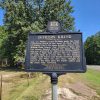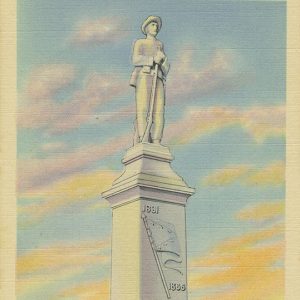calsfoundation@cals.org
Hot Springs Confederate Monument
The Hot Springs Confederate Monument is a commemorative sculpture erected in 1934 at Landmark Plaza by the Hot Springs Chapter No. 80 of the United Daughters of the Confederacy (UDC) to commemorate men who had served in the Confederate army during the Civil War.
The Hot Springs Chapter of the UDC, like its sister chapters around the state, sought to commemorate Confederate soldiers and veterans, and much of its early work focused on the Confederate Section at Hollywood Cemetery, which the chapter took over from the Albert Pike Camp of United Confederate Veterans (UCV) in 1906. That project was completed in 1919 when a granite monument inscribed “Our Confederate Dead” was placed in the southern end of the plot.
The effort to place a sculptural Confederate monument in Hot Springs (Garland County) began in 1907 when Julia A. Davidson moved there from Alabama and spearheaded the movement to raise a monument. In 1913, the Hot Springs chapter held a sale to raise money for the project. Chapter President Mrs. C. M. Roberts stated that “we have not selected a site for the erection of the monument but it will be located at some prominent place where it will be seen and admired by the visitors who come to Hot Springs.” Nine years later, a local newspaper reported that “a move is started to erect a shaft to the heroic Confederate dead in Hollywood Cemetery,” indicating that the UDC might have contemplated another marker at the Confederate Section there.
When enough money was finally raised to purchase a statue a dozen years later, it was placed in a prominent location, as Roberts had sought in 1913, but one with a troubled past—as many at the time likely remembered. Como Triangle (later called Landmark Plaza)—at a plot bounded by Market Street, Ouachita Avenue, and Central Avenue—had been the site of lynchings of African-American men on June 19, 1913, and August 1, 1922. The Hot Springs City Council passed a special ordinance in 1933 to allow the statue to be erected on the triangle, after which a UDC committee was established to select a style and design for the monument.
The dedication of the Hot Springs Confederate Monument was held on June 2, 1934, and tribute was paid to UDC member Mrs. S. E. Dillon, who “has worked faithfully as chairman and treasurer of the monument committee since 1922,” raising funds through “a tag day and from card parties, teas, and other functions.” In addition to the funds raised locally, the Arkansas Division of the UDC provided $1,000 toward the $5,000 project. Rev. J. D. Hammons gave the invocation at the dedication, and the principal speaker was Mrs. C. S. Lothrop of Hope (Hempstead County), president of the UDC’s Arkansas Division, who “paid a very beautiful tribute to the heroes of the Confederate army and to all the Southern heroes, as did Mayor Leo P. McLaughlin in his address of welcome.”
The Hot Springs Confederate Monument features a six-foot marble statue of a Confederate soldier with his gun held at rest before him, standing atop a twelve-foot granite base. The north face of the base is inscribed “1861 / 1865 / CONFEDERATE SOLDIERS,” while the south face features the inscription “ERECTED / IN LOVING MEMORY / BY THE / HOT SPRINGS CHAPTER / UNITED DAUGHTERS / OF THE CONFEDERACY.” In 1953, the City of Hot Springs gave the UDC the deed to the memorial site. The Hot Springs Confederate Monument was listed on the National Register of Historic Places on April 26, 1996.
In June 2020, City Manager Bill Burrough publicly expressed support for the idea of moving the monument to another location. However, according to reports, the UDC refused to meet to discuss the possibility, leaving city leaders without many options, given that the monument stands on private property.
For additional information:
Dodson, Mrs. Thomas F. “Confederate Monuments and Markers in Arkansas.” Arkansas Division UDC, 1960.
“Hot Springs Confederate Monument.” National Register of Historic Places nomination form. On file at Arkansas Historic Preservation Program, Little Rock, Arkansas. Online at https://www.arkansasheritage.com/arkansas-historic-preservation-program (accessed April 18, 2024).
“Keep Alive Their Memory.” Hot Springs New Era, April 17, 1922, p. 4.
Kendall, Cassidy. “City Given 2 Options to Move Rebel Statue.” Arkansas Democrat-Gazette, June 13, 2020, pp. 1B, 3B.
———. “City Stalls on Confederate Statue Relocation.” Sentinel-Record, June 9, 2020, pp. 1A, 2A.
———. “Statue Should Move, CM Says.” Sentinel-Record, June 6, 2020, pp. 1A, 3A.
———. “No Plans to Relocate Statue, UDC Spokesman Says.” Sentinel-Record, June 12, 2020, pp. 1A, 3A.
———. “Pandemic a Priority over Statue, City Says.” Sentinel-Record, July 4, 2020, pp. 1A, 3A.
Lancaster, Guy. “Lynchings Hidden in the History of the Hot Springs Confederate Monument.” Arkansas Times, August 24, 2017, p. 16. Online at https://arktimes.com/news/cover-stories/2017/08/24/lynchings-hidden (accessed April 18, 2024).
Logan, Charles Russell. “Something So Dim It Must Be Holy”: Civil War Commemorative Sculpture in Arkansas, 1886–1934. Little Rock: Arkansas Historic Preservation Program, 1996. Online at https://www.arkansasheritage.com/arkansas-preservation/programs/publications (accessed April 18, 2024).
“Monument to Confederates Unveiled Here.” Sentinel Record, June 3, 1934, p. 3.
“Tomorrow to be Tag Day Here. Will Raise Funds for the Erection of Confederate Monument Here.” Hot Springs New Era, March 14, 1913, p. 1.
Mark K. Christ
Arkansas Historic Preservation Program
 Civil War Markers and Memorials
Civil War Markers and Memorials Early Twentieth Century, 1901 through 1940
Early Twentieth Century, 1901 through 1940 Historic Preservation
Historic Preservation Hot Springs Confederate Monument
Hot Springs Confederate Monument 



Comments
No comments on this entry yet.